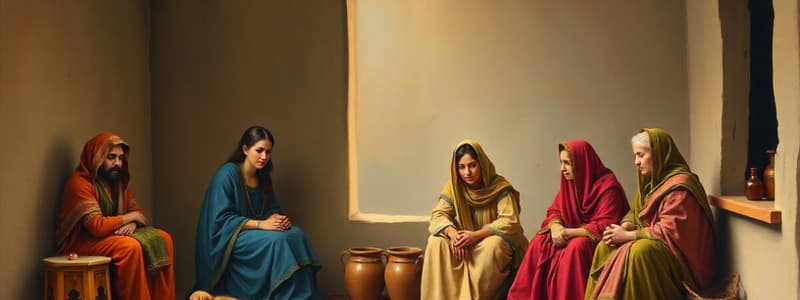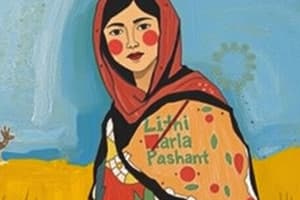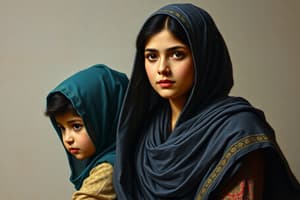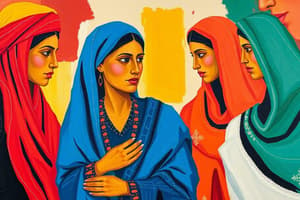Podcast
Questions and Answers
Which of the following statements best encapsulates the role of Pashtunwali in shaping Malala's early experiences as depicted in the excerpt?
Which of the following statements best encapsulates the role of Pashtunwali in shaping Malala's early experiences as depicted in the excerpt?
How does the author juxtapose the 'weighty world of the men' with the world of the women on the veranda, and what does this juxtaposition imply about the perceived value of different forms of social engagement?
How does the author juxtapose the 'weighty world of the men' with the world of the women on the veranda, and what does this juxtaposition imply about the perceived value of different forms of social engagement?
Considering the author's observations of purdah, which of the following philosophical frameworks best elucidates the socio-psychological impact of veiling on individual identity and agency?
Considering the author's observations of purdah, which of the following philosophical frameworks best elucidates the socio-psychological impact of veiling on individual identity and agency?
In the context of cultural hegemony as articulated by Gramsci, how might the practice of purdah be understood beyond its immediate function of female seclusion?
In the context of cultural hegemony as articulated by Gramsci, how might the practice of purdah be understood beyond its immediate function of female seclusion?
Signup and view all the answers
Given the author’s nascent understanding of the world beyond her valley, how might her inclination toward the men's conversations be interpreted through the lens of social constructivism?
Given the author’s nascent understanding of the world beyond her valley, how might her inclination toward the men's conversations be interpreted through the lens of social constructivism?
Signup and view all the answers
From a postcolonial perspective, how might the author's observation of women's freedom within the domestic sphere be analyzed as a form of resistance against external cultural impositions?
From a postcolonial perspective, how might the author's observation of women's freedom within the domestic sphere be analyzed as a form of resistance against external cultural impositions?
Signup and view all the answers
Considering Judith Butler’s theory of performativity, how can the behaviors observed by the author—such as veiling or lowering one’s gaze—be interpreted in the context of gender construction?
Considering Judith Butler’s theory of performativity, how can the behaviors observed by the author—such as veiling or lowering one’s gaze—be interpreted in the context of gender construction?
Signup and view all the answers
If one were to analyze the social dynamics described in the text through the framework of Pierre Bourdieu's concept of 'habitus,' which of the following interpretations would be most accurate?
If one were to analyze the social dynamics described in the text through the framework of Pierre Bourdieu's concept of 'habitus,' which of the following interpretations would be most accurate?
Signup and view all the answers
Applying Michel Foucault's concept of 'power/knowledge,' how might the practice of purdah be understood as a mechanism for social control and the production of specific subjectivities?
Applying Michel Foucault's concept of 'power/knowledge,' how might the practice of purdah be understood as a mechanism for social control and the production of specific subjectivities?
Signup and view all the answers
Using a Marxist intersectional framework, how does the author’s observation of women in purdah reflect the convergence of gender oppression with other forms of social stratification?
Using a Marxist intersectional framework, how does the author’s observation of women in purdah reflect the convergence of gender oppression with other forms of social stratification?
Signup and view all the answers
Flashcards
Pashtunwali Code
Pashtunwali Code
A set of traditional ethical guidelines among the Pashtun people emphasizing hospitality and honor.
Hospitality
Hospitality
The friendly reception and treatment of guests, highly valued in Pashtun culture.
Niqab
Niqab
A type of veil worn by some Muslim women that covers the face, leaving only the eyes visible.
Purdah
Purdah
Signup and view all the flashcards
Burgas
Burgas
Signup and view all the flashcards
Women’s Quarters
Women’s Quarters
Signup and view all the flashcards
Men’s Guest Room
Men’s Guest Room
Signup and view all the flashcards
Weighty World of Men
Weighty World of Men
Signup and view all the flashcards
Veils
Veils
Signup and view all the flashcards
Joy of Freedom
Joy of Freedom
Signup and view all the flashcards
Study Notes
Childhood Experiences in a Pashtun Household
- The author's home was always filled with people, including relatives, neighbors, and friends.
- The author's parents were from a town in the mountains.
- Even when moving, there was always someone sleeping on the floor due to the Pashtun tradition of hospitality.
- Pashtun tradition required opening doors to visitors.
- Women gathered and cooked on the veranda, while men talked politics in the men's quarters.
- The author, as a child, spent time in both the women's and men's sections.
Women's Roles and Public Appearances
- The author observed women differently than men.
- Women's appearances were striking with headscarves, lipstick, and henna.
- Women followed the purdah code covering themselves while in public.
- Some women wore niqabs, which covered their faces.
- Others wore burqas, full-body coverings that completely concealed their bodies.
- Women were required to lower their gazes around men.
- Older women disappeared behind veils, following societal norms.
- Women chatting openly was a new sight for the author.
Gender Roles and Observation
- The author observed that women had different experiences from men.
- Certain societal rules were in place for women and men, such as different sections within the house.
- The author noted the rules and experiences of women, contrasting them with what she observed in the men's section.
- The author was fascinated by the men's conversations; she felt drawn to the men's world.
Personal Reflections
- The author found the men's world compelling, but also felt a pull towards understanding the women's lives.
- The author felt societal rules about women were unfair and uncomfortable.
- The author expressed her desire to understand more fully the differing experiences of women and men.
Studying That Suits You
Use AI to generate personalized quizzes and flashcards to suit your learning preferences.
Description
Explore the rich cultural dynamics of a Pashtun household, focusing on hospitality, communal living, and gender roles. This quiz delves into the traditional practices observed in the author's upbringing, including the significance of women's appearances and their roles within the community. Discover how these traditions shape social interactions and public appearances in Pashtun culture.




